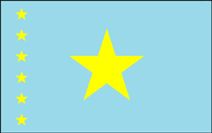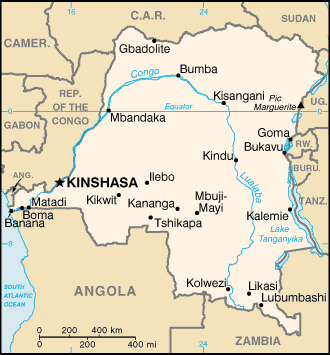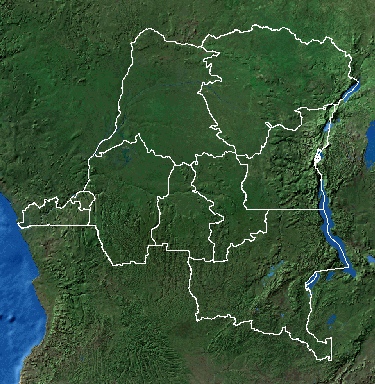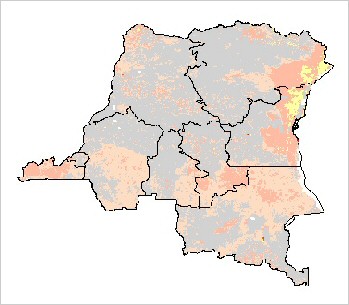|
| 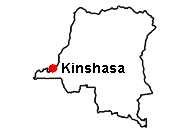 |
| back to top | |
|
Population. No current information. Estimated at 300 and could decline below 100 by 1980. Small populations found in parts of Shaba, Kasai and Kwango Provinces in the southern and southeastern part of country. Kundelungu National Park (7,600 km2) and Upemba National Park (10,000 km2) did contain a few cheetah. Principal Threats. Agricultural development, poaching and loss of habitat. | |
| back to top | |
|
Established as a Belgian colony in 1908, the Republic of the Congo gained its independence in 1960, but its early years were marred by political and social instability. Col. Joseph MOBUTU seized power and declared himself president in a November 1965 coup. He subsequently changed his name - to MOBUTU Sese Seko - as well as that of the country - to Zaire. MOBUTU retained his position for 32 years through several sham elections, as well as through the use of brutal force. Ethnic strife and civil war, touched off by a massive inflow of refugees in 1994 from fighting in Rwanda and Burundi, led in May 1997 to the toppling of the MOBUTU regime by a rebellion backed by Rwanda and Uganda and fronted by Laurent KABILA. He renamed the country the Democratic Republic of the Congo (DRC), but in August 1998 his regime was itself challenged by a second insurrection again backed by Rwanda and Uganda. Troops from Angola, Chad, Namibia, Sudan, and Zimbabwe intervened to support Kabila's regime. A cease-fire was signed in July 1999 by the DRC, Congolese armed rebel groups, Angola, Namibia, Rwanda, Uganda, and Zimbabwe but sporadic fighting continued. Laurent KABILA was assassinated in January 2001 and his son, Joseph KABILA, was named head of state. In October 2002, the new president was successful in negotiating the withdrawal of Rwandan forces occupying eastern Congo; two months later, the Pretoria Accord was signed by all remaining warring parties to end the fighting and establish a government of national unity. A transitional government was set up in July 2003. Joseph KABILA as president and four vice presidents represented the former government, former rebel groups, and the political opposition. The transitional government held a successful constitutional referendum in December 2005 and elections for the presidency, National Assembly, and provincial legislatures in 2006. KABILA was inaugurated president in December 2006. The National Assembly was installed in September 2006. Its president, Vital KAMERHE, was chosen in December. Provincial assemblies were constituted in early 2007, and elected governors and national senators in January 2007. | |
| back to top | |
|
Area: total: 2,345,410 sq km; land: 2,267,600 sq km; water: 77,810 sq km Climate: tropical; hot and humid in equatorial river basin; cooler and drier in southern highlands; cooler and wetter in eastern highlands; north of Equator-wet season April to October, dry season December to February; south of Equator-wet season November to March, dry season April to October Terrain: vast central basin is a low-lying plateau; mountains in east Land use: arable land: 2.86%; permanent crops: 0.47%; other: 96.67% (2005) Natural resources: cobalt, copper, cadmium, petroleum, industrial and gem diamonds, gold, silver, zinc, manganese, tin, germanium, uranium, radium, bauxite, iron ore, coal, hydropower potential, timber Natural hazards: periodic droughts in south; volcanic activity Environment-current issues: poaching threatens wildlife populations; water pollution; deforestation; refugees who arrived in mid-1994 were responsible for significant deforestation, soil erosion, and wildlife poaching in the eastern part of the country (most of those refugees were repatriated in November and December 1996) Environment-international
agreements: | |
|
|
|
| back to top | |
|
Population: 62,660,551 (July 2006 est.) Age structure: 0-14 years: 47.4% (male 14,906,488/female 14,798,210); 15-64 years: 50.1% (male 15,597,353/female 15,793,350); 65 years and over: 2.5% (male 632,143/female 933,007) (2006 est.) Median age: total: 16.2 years; male: 16 years; female: 16.4 years (2005 est.) Population growth rate: 3.07% (2006 est.) Infant mortality rate: total: 88.62 deaths/1,000 live births; male: 96.9 deaths/1,000 live births, female: 80.1 deaths/1,000 live births (2006 est.) Life expectancy at birth: total population: 51.46 years, male: 50.01 years; female: 52.94 years (2006 est.) Total fertility rate: 6.45 children born/woman (2006 est.) HIV/AIDS - adult prevalence rate: 4.2% (2003 est.) HIV/AIDS - people living with HIV/AIDS: 1.1 million (2003 est.) HIV/AIDS - deaths: 100,000 (2003 est.) Major
infectious diseases: food or waterborne diseases: bacterial and protozoal diarrhea, hepatitis
A, and typhoid fever Ethnic groups: over 200 African ethnic groups of which the majority are Bantu; the four largest tribes - Mongo, Luba, Kongo (all Bantu), and the Mangbetu-Azande (Hamitic) make up about 45% of the population Religions: Roman Catholic 50%, Protestant 20%, Kimbanguist 10%, Muslim 10%, other syncretic sects and traditional beliefs 10% Languages: French (official), Lingala (a lingua franca trade language), Kingwana (a dialect of Kiswahili or Swahili), Kikongo, Tshiluba Literacy: definition: age 15 and over can read and write French, Lingala, Kingwana, or Tshiluba; total population: 65.5%; male: 76.2%; female: 55.1% (2003 est.) | |
| back to top | |
|
Data code: CG Government type: republic Independence: 30 June 1960 (from Belgium) Legal system: based on Belgian
civil law system and tribal law; has not accepted compulsory ICJ jurisdiction | |
| back to top | |
|
Economy-overview: The economy of the Democratic Republic of the Congo - a nation endowed with vast potential wealth - is recovering from two decades of decline. Conflict, which began in August 1998, dramatically reduced national output and government revenue, increased external debt, and resulted in the deaths of perhaps 3.5 million people from violence, famine, and disease. Foreign businesses curtailed operations due to uncertainty about the outcome of the conflict, lack of infrastructure, and the difficult operating environment. Conditions began to improve in late 2002 with the withdrawal of a large portion of the invading foreign troops. The transitional government reopened relations with international financial institutions and international donors, and President KABILA has begun implementing reforms. Much economic activity still occurs in the informal sector, and is not reflected in GDP data. Economic stability improved during the period 2003-06, although an uncertain legal framework, corruption, and a lack of transparency in government policy continues to hamper growth. In 2005-06, renewed activity in the mining sector, the source of most export income, boosted Kinshasa's fiscal position and GDP growth. The International Monetary Fund program for the DRC, however, expired at the end of March 2006 and probably will not be reinstated until mid-2007. Government reforms and improved security may lead to increased government revenues, outside budget assistance, and foreign direct investment in 2007. GDP - real growth rate: 7.5% (2006 est.) GDP - composition by sector: agriculture: 55%; industry: 11%; services: 34% (2000 est.) Labor force: 15 million (2006 est.) Unemployment: NA Population below poverty: NA Industries: mining (diamonds, gold, copper, cobalt, coltan zinc), mineral processing, consumer products (including textiles, footwear, cigarettes, processed foods and beverages), cement, commercial ship repair | |
|
Agriculture-products: coffee, sugar, palm oil, rubber, tea, quinine, cassava (tapioca), palm oil, bananas, root crops, corn, fruits; wood products Exports: $1.108 billion (f.o.b., 2004 est.) Exports-commodities: diamonds, copper, crude oil, coffee, cobalt Exports-partners: Belgium 38.2%, US 17.8%, China 11.7%, France 8%, Finland 7.8%, Chile 4.3% (2005) Imports: $1,319 million (f.o.b., 2004 est.) Imports-commodities: foodstuffs, mining and other machinery, transport equipment, fuels Imports-partners: South Africa 17.7%, Belgium 15.3%, France 8.6%, Kenya 7.5%, Zambia 6.6%, Germany 4.4%, US 4.3%, Cote d'Ivoire 4.1% (2005) Currency: Congolese franc (CF) Exchange rates: Congolese francs per US dollar - 464.69 (2006), 437.86 (2005), 401.04 (2004), 405.34 (2003), 346.49 (2002) |
|
| back to top | |
|
Telephone system: general assessment: poor; domestic: barely adequate wire and microwave radio relay service in and between urban areas; domestic satellite system with 14 earth stations; international: country code - 243; satellite earth station - 1 Intelsat (Atlantic Ocean) Radio broadcast stations: AM 3, FM 11, shortwave 2 (2001) Television broadcast stations: 4 (2001) Internet country code: .cd Internet hosts: 1,778 (2006) Internet users: 140,600 (2005) | |
| back to top | |
|
Marker L., Malouf J. and Malouf A. 1999. Appendix 2: The status of the wild cheetah in its range countries. In: 1999 International Cheetah Studbook. http://www.cia.gov/cia/publications/factbook/geos/cg.html (last update on 10 January, 2006) http://www.lib.utexas.edu/maps/map_sites/country_sites.html#congo | |
